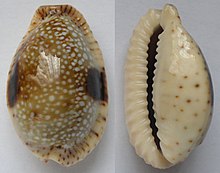Naria nebrites
Appearance
| Erosaria nebrites | |
|---|---|

| |
| Two views of a shell of Erosaria nebrites, anterior end towards the top | |
| Scientific classification | |
| Kingdom: | |
| Phylum: | |
| Class: | |
| (unranked): | |
| Superfamily: | |
| Family: | |
| Genus: | |
| Species: | E. nebrites
|
| Binomial name | |
| Erosaria nebrites (Melvill, 1888)
| |
| Synonyms[1][2] | |
| |
Erosaria nebrites, common name the false margined cowry, is a species of sea snail, a cowry, a marine gastropod mollusk in the family Cypraeidae, the cowries.[1]
Subspecies and formae
- Erosaria nebrites ceylonica (f) Schilder, F.A. & M. Schilder, 1938 [3]
- Erosaria nebrites oblonga (f) Melvill, J.C., 1888 [4]
Description
This section is empty. You can help by adding to it. (May 2010) |
Distribution
This species is distributed in the Red Sea and in the Indian Ocean along East Africa, Eritrea, Kenya, Somalia, Sri Lanka and Singapore.
References
- ^ a b Erosaria nebrites Melvill. WoRMS (2009). Erosaria nebrites Melvill. Accessed through the World Register of Marine Species at http://www.marinespecies.org/aphia.php?p=taxdetails&id=216854 on 20 October 2010 .
- ^ Gastropods.com : Erosaria nebrites; accessed : 20 October 2010
- ^ Gastropods.com : Erosaria nebrites ceylonica; accessed : 20 October 2010
- ^ Gastropods.com : Erosaria nebrites oblonga; accessed : 20 October 2010
- Verdcourt, B. (1954). The cowries of the East African Coast (Kenya, Tanganyika, Zanzibar and Pemba). Journal of the East Africa Natural History Society 22(4) 96: 129-144, 17 pls.
External links
